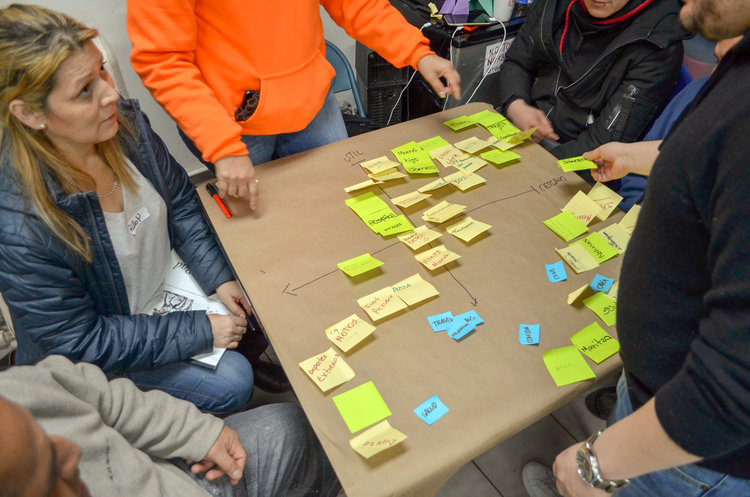After months of research and planning, I was able to implement a series of workshops in partnership with NICE. My collaboration with the agency began with a conversation around the development of an app called, Jornaler@. An app initiated from an art residency program at NICE. The app integrates technology to support workers against wage theft. [1] During the development of the app, I offered my practice as a designer and artist to support the Jornalero community. NICE was able to open a second iteration of an art residency program where I was granted the autonomy to implement workshops aimed to practice problem-solving using design thinking and art-making. I suggested working to problem solve within the spectrum of a large issue; the separation of immigrant families. Alternatively, I could facilitate developed interests that were inspired from the workshops.
Transformation of Hypothesis
Utilizing my theories and considering the research I had done, I moved forward to present defined problem to solve with the community. I developed an infrastructure to facilitate the experience by designing a pedagogical framework to carry out five two-hour workshops over a span of ten weeks. As the word got out about the art residency program in the Jornalero community, NICE and I had to limit how many people could participate in the workshops. It was assumed that there would be a cohort of people but time frame of the workshops prevented consistency of people. The workshops began with 15 participants but resulted in impacting close to 50 Jornaleros.
As I attempted to follow through with design as a way to problem solve, I quickly understood my project was not going to be about resolving a problem; it was introducing design to a community that would not normally ever use design thinking. Therefore, my project explores how design thinking through socially engaged art might support the development of community agency for a Jornalero community in Queens, NY that has been targeted by Immigration and Customs Enforcement (ICE).
Scope of Project
The project objective is to:
1) design the infrastructure of the workshops in relationship to the project goals.
2) Translate design thinking by using a pedagogical facilitation approach with the Jornalero community.
3) Utilize my studio art background to curate culturally relevant art-making practices to activate collective dialogue, collective memory dialogue, and enter a space of collective responsibility and critical thinking.
The project purpose is to:
1) introduce design thinking through an engaged learning process. The approach is to use art as the vehicle for understanding and delivering a message; for art is a way to understand the world.
2) Access community strengths.
3) Celebrate art and culture.
4) Practice capacity-building.
5) Lastly, work towards developing a collective responsibility.
The project goals are to:
1) exercise and harness modes of expressive thinking to activate critical thinking. By activating critical thinking participants will question their problem-solving approaches during the workshops and consider alternative perspectives. Often from shared knowledge developed during collective dialogue. The approach will be by designing holistic workshop experiences of “I feel, therefore I think.” It is there, the entry point to begin using design to problem solve.
2) Practice community building principles to enable collective responsibility. The approach will come from developing accountability and exercising autonomy between participants of the workshop.
3) Deconstruct the design process towards a decolonized process. The method is to prevent oppressive forms of facilitating and introducing design thinking. The process of community facilitation has to utilize an ethnographic, sociological and anthropological approach to assure proper community and human-centered design.
The project is not about communities creating art, more specifically, from a fine arts perspective. The production of art-making by individuals and as a collective may be interpreted as art forms, but the art-making is what will ground the project and the transaction for building a collective responsibility. That is why the approach is called Socially Engaged Art. Through the conceptual process of generating art, the process of creating allows for members to enter a space of flow. Therapeutic interpretation and the development of emotional intelligence naturally emerges.
Designed Conditions
The most critical condition is the leadership and guidance of NICE. The organization has developed a joint practice with the community of whom they service and advocate. It would be crucial to leverage the insights and approaches used by the organization. The second condition is time. During the project length, five workshops were facilitated to carry out a framework and interests of the community. Each workshop was a two-hour time frame and spread across a ten-week period. Additional conditions were based on access to materials, project funding, and consistent transparency. The core structure of the workshops consisted of ceremony and ritual to open and close group dynamics that included continuous feedback from the participants. A review of the previous workshops, sensorial exercises to prepare for activities, project-driven activities centered around SEA practices, and optional requests for homework.
References:
[1] The Worker Institute, “Jornaler@ App: Grow Knowledge, Build Community, End Wage Theft,” Cornell University, accessed October 10, 2017, http://www.ilr.cornell.edu/worker-institute/new-york-state-projects/jornaler-app-grow-knowledge-build-community-end-wage-theft.

